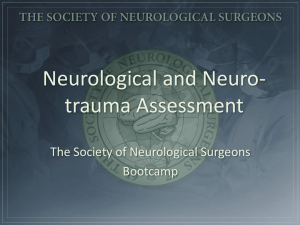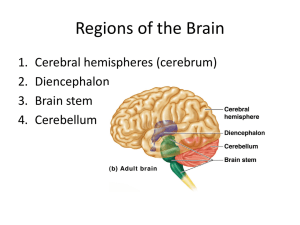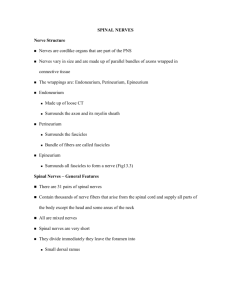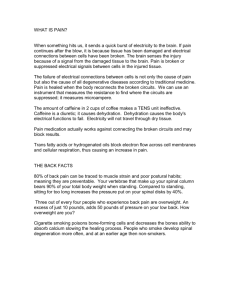Nervous System Lecture- Part II
advertisement
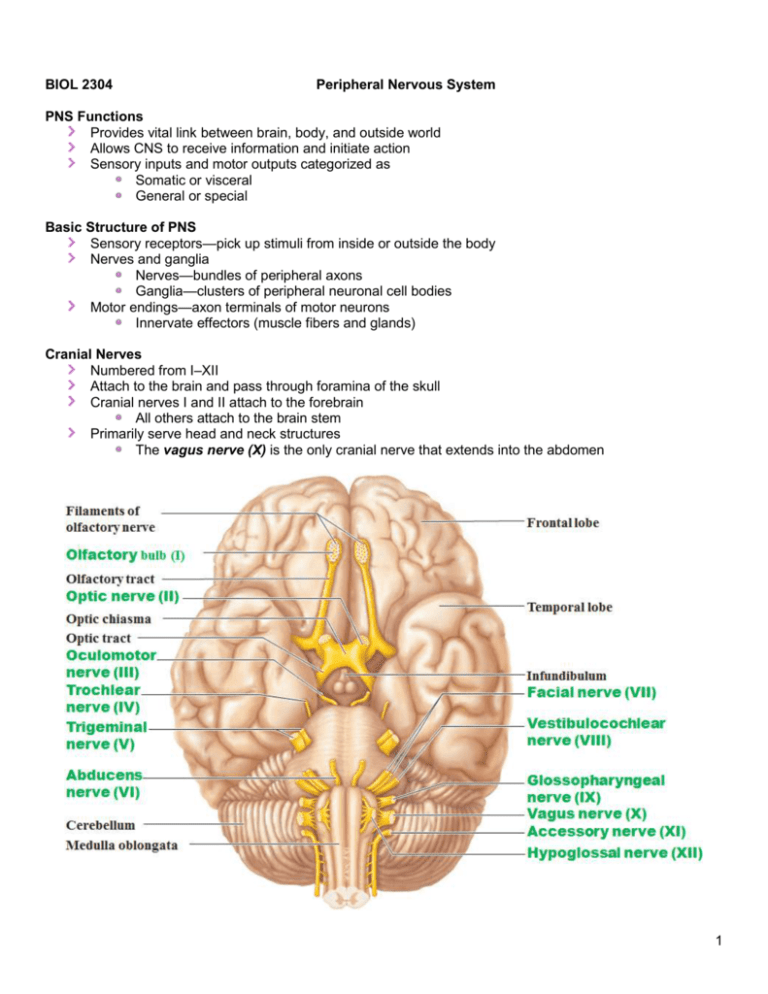
BIOL 2304 Peripheral Nervous System PNS Functions Provides vital link between brain, body, and outside world Allows CNS to receive information and initiate action Sensory inputs and motor outputs categorized as Somatic or visceral General or special Basic Structure of PNS Sensory receptors—pick up stimuli from inside or outside the body Nerves and ganglia Nerves—bundles of peripheral axons Ganglia—clusters of peripheral neuronal cell bodies Motor endings—axon terminals of motor neurons Innervate effectors (muscle fibers and glands) Cranial Nerves Numbered from I–XII Attach to the brain and pass through foramina of the skull Cranial nerves I and II attach to the forebrain All others attach to the brain stem Primarily serve head and neck structures The vagus nerve (X) is the only cranial nerve that extends into the abdomen 1 Cranial Nerves Cranial Nerve I – Olfactory A sensory nerve involved in the sense of smell. 2 Cranial Nerve II – Optic Transmits visual information from the retina to the brain Cranial Nerve III – Oculomotor Controls most of the eye's movements, including constriction of the pupil and maintaining an open eyelid by innervating the Levator palpebrae superiors muscle. Cranial Nerve IV – Trochlear A motor nerve (a “somatic efferent” nerve) that innervates a single muscle: the superior oblique muscle of the eye. 3 Cranial Nerve V – Trigeminal Contains both sensory and motor fibers. It is responsible for sensation in the face and certain motor functions such as biting, chewing, and swallowing. 4 Cranial Nerve VI – Abducens A somatic efferent nerve that controls the movement of a single muscle, the lateral rectus muscle of the eye, in humans Cranial Nerve VII – Facial Controls the muscles of facial expression, and functions in the conveyance of taste sensations from the anterior two-thirds of the tongue and oral cavity. It also supplies preganglionic parasympathetic fibers to several head and neck ganglia. 5 Cranial Nerve VIII – Vestibulocochlear Is responsible for transmitting sound and equilibrium (balance) information from the inner ear to the brain. Cranial Nerve IX – Glossopharyngeal Receives general sensory fibers (ventral trigeminothalamic tract) from the tonsils, the pharynx, the middle ear and the posterior 1/3 of the tongue. Receives special sensory fibers (taste) from the posterior one-third of the tongue. Receives visceral sensory fibers from the carotid bodies, carotid sinus. Supplies parasympathetic fibers to the parotid gland via the otic ganglion. Supplies motor fibers to stylopharyngeus muscle, the only motor component of this cranial nerve. Contributes to the pharyngeal plexus. 6 Cranial Nerve X – Vagus Parasympathetic innervation of organs The vagus nerve contributes to the innervation of the viscera. Besides output to the various organs in the body, the vagus nerve conveys sensory information about the state of the body's organs to the central nervous system. 80-90% of the nerve fibers in the vagus nerve are afferent (sensory) nerves communicating the state of the viscera to the brain. 7 Cranial Nerve XI – Accessory The Spinal Accessory nerve controls specific muscles of the shoulder and neck. It is considered a cranial nerve because part of it was formerly believed to originate in the brain. It provides motor innervation from the central nervous system to two muscles of the neck: the sternocleidomastoid muscle and the trapezius muscle. Cranial Nerve XII – Hypoglossal It supplies motor fibers to all of the muscles of the tongue, except the palatoglossus muscle, which is innervated by the vagus nerve 8 Spinal Nerves 31 pairs—contain thousands of nerve fibers Connect to the spinal cord Named for point of issue from the spinal cord 8 pairs of cervical nerves (C1–C8) 12 pairs of thoracic nerves (T1–T12) 5 pairs of lumbar nerves (L1–L5) 5 pairs of sacral nerves (S1–S5) 1 pair of coccygeal nerves (Co1) Spinal Nerves Although there are seven cervical vertebrae (C1-C7), there are eight cervical nerves (C1-C8) All nerves emerge above their corresponding vertebrae except for C8 The C8 nerve emerges below the C7 vertebra 9 Spinal Nerves Connect to the spinal cord by the dorsal root and ventral root Dorsal root – contains sensory fibers Cell bodies – located in the dorsal root ganglion Ventral root – contains motor fibers arising from anterior gray column Spinal Nerves Branch into dorsal ramus and ventral ramus Dorsal and ventral rami contain sensory and motor fibers Rami communicantes connect to the base of the ventral ramus Lead to the sympathetic chain ganglia Singular: Ramus communicans Nerve Plexuses Ventral rami form nerve plexuses Cervical Located under sternocleidomastoid Formed by rami of C1-C4 Supplies nerves of neck (phrenic nerve) Brachial Located in neck and axilla Formed by rami of C5-C8 Supplies nerves of upper limbs (radial, ulnar nerves) Lumbar Formed by rami of L1-L4 Supplies nerves of anterior lower limb (femoral nerve) Sacral Formed by rami of L4-S4 Supplies nerves of gluteal muscles, perineum, and posterior lower limb (sciatic nerve) Autonomic Nervous System The ANS responds to stimuli by activating smooth muscle, cardiac muscle, and glands. Sympathetic division – fight/flight Parasympathetic division – rest/digest ANS Regulates visceral functions Heart rate Blood pressure Digestion Urination Contrast with the somatic nervous system which responds to stimuli by activating skeletal muscle 10 Comparing SNS and ANS Somatic Nervous System 1 motor neuron from spinal cord to skeletal muscle Axon is myelinated; impulse is rapid Skeletal muscle movement Autonomic Nervous System 2 motor neuron chain from brain stem or spinal cord Axon is unmyelinated Smooth or cardiac muscle movement or gland secretion 11 Comparison of Somatic and Autonomic Systems Autonomic Nervous System (ANS) Sympathetic NS Pre-ganglionic neuron arises in thoracic or lumbar spinal cord segment and is short Post-ganglionic neuron long and synapses onto target organ/gland. Parasympathetic NS Pre-ganglionic neuron arises in brainstem or sacral spinal cord segment and is long Post-ganglionic neuron short and close to and synapses onto target organ/gland Most organs are dually innvervated by both branches of ANS Allows for fine tuning of body for homeostasis Autonomic Pathways 12



